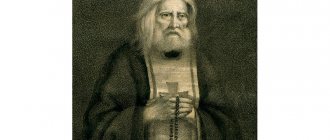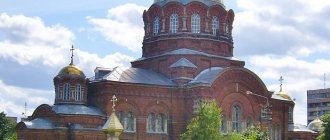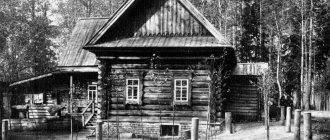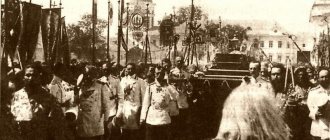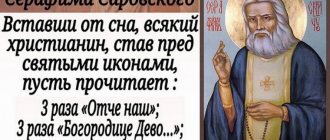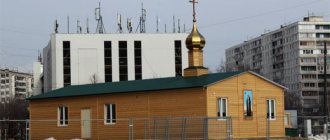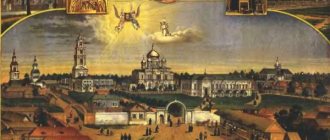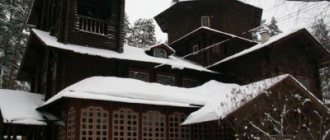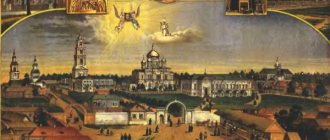We are not on the map, we do not have a name
How many names has this city changed: Moscow Center-300, then Arzamas-75, Arzamas-16, Kremlev and finally Sarov...
In the old days, we, residents of the secret city, came to the Kazansky station in Moscow and took tickets home from the box office with the inscription: “Ticket sales by reservation.” No one there ever bought tickets with any reservation, but we walked past the longest tails to other ticket offices and took a ticket “to Bereshchino” from an empty window. At first our postal address was Moscow-center-300, then Arzamas-75, then Arzamas-16. Only in conversation they never used these names, but simply said: “I’ll be in the City in a week.” “Excuse me, are you from the City?” “Well, in the City it’s always there...”
Yes, there was a city, but it received the name “Sarov” only in 1995. For many years the name itself was banned. However, there were times when Sarov was on the map, but the city was not.
Sarov Caves
The construction of the monastery was accompanied by the construction of an underground city, which was also built thanks to Hieroschemamonk John. At that time he lived in one of the mountain caves. Then the caves grew, and cells were set up in them for solitude and immersion in prayer. In 1711, the Church of Saint Anthony and Theodosius was built underground.
The Sarov desert was filled with life. Novices and monks came here from all cities. Everyone was given a job. Some conducted services, some were engaged in the construction of new cells, some collected berries and mushrooms. So gradually a whole city was formed around the church, which served as the prototype of the monastery.
At that time, John drew up the rules of the monastery, following strict rules. Sarov was known as an academy of monasticism. After their stay in the Monastery, the ascetic monks moved on, spreading the Sarov Rule. Almost all of them were subsequently appointed abbots or treasurers in various monasteries.
Sarov Desert
Here, at the confluence of the Sarovka and Satis rivers, there was once a large, rich ancient settlement, destroyed in the first half of the 13th century by Batu’s invasion. And there were no people here for four hundred years. By the end of the 17th century, a forest had grown between the remains of the city ramparts, ditches and walls, but human bones and fragments of weapons still lay untidy after the great slaughter. This “desert”, drowned in a sea of forests, that is, uninhabited, remote from populated areas, was chosen by the founder of the Sarov monastery, John, for a monastic solitary life. This was in 1692. The communal Assumption Sarov Hermitage was famous for its strict regulations. The inhabitants prayed, worked and studied. Many abbots of the largest monasteries in Russia came from here, there was a rich library, and new agricultural crops, for example, potatoes, were spread around here. Here were the first water supply systems in the area, steam heating, and later a power plant. According to the charter, the brethren themselves elected a rector and treasurer from among their ranks. Pilgrims were housed and fed free of charge, the infirm were given shelter, and the sick were treated. Here, two hundred years ago, the great Saint Seraphim of Sarov, glorified before the first Russian revolution, monasticated. Thousands of people flocked here to him to receive help and consolation.
But Soviet power came, the monastery was destroyed, the icons were burned, the relics of St. Seraphim of Sarov were secretly taken out, and the monastery seemed to be covered in darkness. A colony for minors was set up in its premises, then a Gulag institution for adults, and during the war there was a small plant No. 550, where shells for howitzers and Katyushas were sharpened.
How to get there?
All pilgrims are recommended to visit such a sacred place as the Sarov Hermitage. How to get to this place?
From Nizhny Novgorod buses depart to Diveevo from the Shcherbinki bus station. At Moskovsky Station there is also a stop for minibuses that also travel in this direction. When traveling by car, you can also visit the ancient city of Arzamas.
Excursion bus tours are regularly carried out from Nizhny Novgorod to Diveevo. You can book a tour and learn more about this amazing place.
Today the Sarov Desert is a museum. Anyone who wants to visit a truly holy place can visit it.
Academy town in the woods
The unique forests of the present-day Mordovian Nature Reserve survived precisely because of the Sarov Desert. Caring about preserving desert habitation, she bought and saved the surrounding vast forest lands and never owned land inhabited by peasants, which saved the monastery from secularization in Catherine’s time. It was this immersion in the forests, remoteness and seclusion of the place that determined its future as a secret site in the mid-twentieth century.
When the Americans created, tested and used their atomic bomb and began to effectively use it in international politics, Russia had to look for an answer to this historical challenge.
In 1946, the former Sarov Desert was chosen as the location for Design Bureau No. 11. This was the name given to the center of the Soviet nuclear project at the very beginning. The monastery complex and part of the Mordovian State Reserve (231 sq. km) were transferred to the Construction Department No. 880 of the USSR Ministry of Internal Affairs (Dubrovlag). In a short time (not without the labor of the prisoners), a city was built here and a production base was created.
Photo by Selverova Victoria
The best scientists, engineers, and production workers were gathered here from Moscow, Leningrad, Gorky, Kazan, Kharkov, and Sverdlovsk. The best students were selected from the country's leading universities. Specialists in hundreds of areas of scientific knowledge and engineering practice are concentrated here.
The city lived and worked in complete secrecy. Until the mid-1950s, employees of the Nuclear Center and their families did not even go on vacation - only on business trips. Later, permanent passes were introduced for citizens. Here, as it were, monastic life continued “according to strict rules.” The residents had an interesting and important job, a fairly high quality of life (excellent kindergartens and schools, a good level of medicine, a good salary with “zonal workers”). But “outside the zone,” when leaving, they could not be told that their city was “closed,” where it was located, or what they were doing; it was impossible to invite relatives and friends to visit. Any contact with foreigners should also be excluded.
It was forbidden to photograph the surviving monastery buildings: “outside the zone” the secret city would be immediately recognizable from photographs. At one time, I, accustomed to keeping silent and composing, was amazed: in every church “on the mainland” there was an icon of Seraphim of Sarov with a panorama of our monastery.
The city became a tool for achieving one main goal - the creation and improvement of nuclear weapons. Here, in Sarov, the nuclear monopoly of the West was put to an end.
What to see
The Seraphim of Sarov Desert is surrounded by a pine forest. On the way to the shrine, everyone literally merges with the surrounding nature. Majestic pine trees and fresh mountain air give strength and good mood. There are small signs with arrows on the trees. Using these signs it is easy to find the church. There is a hut at the edge of the forest, and not far from it there is a well. They were restored from photographs and paintings of 1903. Under the canopy there is a large stone, reminiscent of the one on which Seraphim prayed for a thousand days and nights. In Georgia they believe that it, like the real one, can cure any ailment. Tens of thousands of pilgrims come to this stone every year; prayer services are held near it.
Near the stone there is an inscription with the words of the saint from Iberia - the inheritance of the Mother of God. It is presented in Georgian and Russian languages. Next to the hut and the well there is a small stone church. Its walls are decorated with paintings of images of the life of Seraphim of Sarov. The Georgian Bishop Seraphim (Jojua) personally took part in the painting of the church. There are no daily services in the temple. There everyone remains alone with God and prays about the most secret things. And every year on August 1, the day of the discovery of the relics of Seraphim, a huge number of pilgrims gather in the desert and participate in the liturgy, which is held in the open air in the forest, since everyone cannot fit in the church.
The road to the temple through the forest with signs on the trees, © Masha Malinovskaya
In the high energy region
Japan has learned well how easily nuclear weapons can be used by their sole owner and what happens to those who find themselves under attack. Since Sarov stood opposite Los Alamos, instead of endless fear, there was a balance of fear. There is little good in this. But perhaps mutual nuclear deterrence gives humanity a chance to avoid self-destruction until it becomes smarter and kinder.
How to become smarter and kinder? “Acquire a peaceful spirit, and thousands will be saved around you,” said St. Seraphim of Sarov.
In Hebrew, "Seraphim" means "fiery." In the difficult 1990s, many began to see St. Seraphim as the patron saint of Sarov nuclear scientists and everyone working in the field of high energy density physics. In Sarov, an outstanding level of science and the living memory of the people and the Church about St. Seraphim and other holy ascetics are brought together. This cannot be an accident. And as soon as the city acquired its original name, the need to restore the Assumption Sarov Hermitage became clear, and with it the once broken unity of our history.
2003 marked one hundred years since the glorification of St. Seraphim. Great celebrations took place in Sarov with the participation of high representatives of all the Local Orthodox Churches of the world. The temple, which was the first to be consecrated in the name of the saint a hundred years ago, was restored and reopened. In 2006 the monastery was restored. In a city where monastery churches were blown up or remodeled, where for many years believers prayed in the forest near the Far Hermitage of the Reverend, now the liturgy is served on 11 altars. Metropolitan Georgy of Nizhny Novgorod and Arzamas, the Nuclear Center, and the townspeople are taking care of the restoration of the monastic heritage and the construction of new parish churches. There are now more than 90 thousand residents in Sarov. It remains closed - no longer due to secrecy, but for security reasons as a nuclear weapons center in our troubled times.
Closing of the monastery
The destruction of the monastery began in 1918, when an instructor first arrived in Sarov from the district town of Temnikova with the right to establish a commune here. The monks, in turn, asked to organize a labor artel in the monastery with a charter reminiscent of the monastery charter. However, the Temnikovsky land department considered that the monks, due to their civic immaturity, were incapable of self-government and taking initiative in running a large farm on new socialist principles.
In September 1918, the first OGPU task force arrived at the monastery demanding a contribution of 300 thousand rubles, and in November a one-time emergency tax in the amount of one million rubles was imposed on the Sarov Pustyn. Following this, a campaign began to open and destroy the relics of Orthodox saints. On November 17, 1920, by decision of the IX Congress of Soviets of the city of Temnikov, the commission opened the shrine containing the relics of St. Seraphim.
The economy of the Sarov Monastery was ruined, the shrines were desecrated, the relics of the venerable elder were taken away to an unknown direction. In March 1927, a government decision was made to liquidate the Sarov Monastery; the remaining property and buildings were transferred to the jurisdiction of the Nizhny Novgorod NKVD department.
God-given freedom and security regime
The close attention of the country's leadership, the strict official hierarchy, the directive deadlines for execution, secrecy and discipline, the high level of professional and personal qualities of the people gathered here, their enthusiasm and awareness of involvement in solving problems of national and global scale - all this gave the facility's employees the right to see themselves as special closed community of high status. Of course: here Academician Zeldovich gathered young specialists for weekly seminars (now they would say brainstorming sessions), here they invented, designed and tested something that no one had ever done before. They say that it was with these words that the curator of the atomic project, Lavrentiy Beria, responded to reports about the too free conversations of too smart physicists: “These people are doing something that no one has ever done. If we stop them from talking, they will stop thinking. However, watch."
Those who explored, discussed and explained complex physical processes could not ignore what was happening in the world. Here they not only listened to “enemy voices”, but also freely discussed what they heard. And they were calm about “wiretapping” their phones. Sometimes they remarked: “God hears and sees you all the time - so what?”
Iskra channel-1
Andrei Dmitrievich Sakharov, who was an employee of VNIIEF until 1969, did not suddenly become involved in politics. In the 50s, he and his colleagues solved the puzzling problem of creating a thermonuclear explosive device that would not be the size of a house (they just tested this in America). Then he argued to Khrushchev that there was no point in testing a 100 megaton bomb (“Kuzka’s mother”), it would cause great harm to the entire planet (the test did take place at half power). Then, also together with his colleagues, he achieved the cessation of ground-based nuclear tests.
This spirit of selfless service, without ideological blinders, was also present in the Sarov monastery. Here, at the request of the sister of Radishchev, who was exiled in Siberia in 1790, the monks saved his papers. By that time, the Sarov desert had a rich library: even the founder of the desert, the learned schemamonk John, carefully collected historical works, books, papers and manuscripts. And he ended his days in the prison of the Secret Chancellery in St. Petersburg in 1737 - because of lists of prohibited works discovered in the monastery. What seditious things did the monks copy? “Objection to the announcement of monasticism” by Rodyshevsky, directed against the interference of secular authorities in monastic life. Moreover, John himself, and many of the monks of the desert, and the Monk Seraphim did a lot to convert the Old Believers - and this was not easy, because just for communicating with the “Kerzhenskys” the authorities took note.
Today they say that St. Seraphim allowed work here on the creation of nuclear weapons, since they were a real shield and fence for Russia. Today it still protects us, but the main threat has become new means of war - informational, economic, cultural, from which you cannot defend yourself with a nuclear shield.
When perestroika broke out and the science of the former Soviet Union was suffocating from lack of money, from the neglect of the authorities and society, it was our Church that proclaimed to the whole world that it considered the work of the Nuclear Center to be the most important for the Fatherland. This happened in 1996 at the cathedral hearings “Nuclear Weapons and National Security of Russia,” held on the initiative of Sarov scientists.
Elena Yarovitsyna’s competition work is published as part of the “Places of Memory” projectHistory of the Sarov Desert and the city of Sarov
In the south of the Nizhny Novgorod region, 200 kilometers from Nizhny Novgorod, at the confluence of the Sarovka and Satis rivers, stands the city of Sarov. In the Nizhny Novgorod region, this is a city with the most extraordinary history. For many years, mention of it was prohibited and its location kept secret.
Sarov settlement
The first buildings discovered by archaeologists in the vicinity of Sarov date back to the second half of the 1st century BC. These places were then inhabited by the Gorodets tribes, who built fortified settlements. They were called fortifications. This territory became part of the Sarov settlement. Later these lands were inhabited by Mordovian tribes. All information about their way of life and traditions is based on the results of archaeological excavations.
During the time of the Golden Horde, according to legend, the Tatars built the Saraklych fortress on the territory of the Sarov settlement, which means “Golden Saber”. After Ivan the Terrible captured Kazan, the Saraklych fortress also fell. The Sarov settlement fell into disrepair in the 13th century. These places remained deserted until the arrival of the first Russian monks. The first desert dweller, the monk Theodosius, who settled on the Sarov settlement in 1664, spoke about miracles: the ringing of bells from underground, the extraordinary radiance emanating from the mountain on which the settlement was located.
Creation of the Sarov Desert
The founder of the Sarov Hermitage is considered to be Hieroschemamonk John, a monk of the Arzamas Vvedensky Monastery. In 1705, he received a gift from the baptized Tatar prince Daniil Kugushev of 30 acres of land on the Sarov settlement. And he immediately writes a petition to Moscow for permission to build a church. The place was chosen well: centuries-old forests, abundance of spring water, peace and quiet. And at the same time, just to the west there was an ancient postal road along which one could get to Nizhny Novgorod through Arzamas, and through Ardatov to Vladimir and Moscow.
Holy Dormition Sarov Hermitage
300 years ago, by a special decree of Peter I, it was allowed to build a church in the name of the Most Holy Theotokos and her Life-Giving Source on the site of an ancient Mordovian settlement. This wooden church was built in 50 days. June 29, 1706 is the day of the founding of the Holy Dormition Sarov Hermitage.
Sarov Caves
Simultaneously with the construction of the monastery, the construction of an “underground city” was underway. It was started by Hieroschemamonk John, when he dug a cave in the mountain for a temporary home. Then the caves expanded, and cells for prayerful solitude were built in them. In 1711, a church was consecrated underground in the name of Saints Anthony and Theodosius.
Life began to boil in the Sarov desert. Having heard about the new monastery, monks and novices came from everywhere. There was enough work for everyone: some conducted services, some built new cells, some picked mushrooms and berries. Soon a whole town grew up around the new temple - the prototype of the monastery. The Sarov charter was compiled by John according to strict models. Sarov was called the “academy of monasticism.” Sarov ascetic monks dispersed throughout the country, carrying with them the rules of the Sarov desert. They became abbots and treasurers of the monasteries: Valaam, Trinity-Sergius Lavra, Sanaksar and Florishcheva Monasteries.
Seraphim of Sarov
The Sarov monastery was glorified by the great Russian saint Seraphim of Sarov (in the world Prokhor Moshnin). He was born on July 19, 1754 in Kursk, into a merchant family. His father died before finishing the construction of the temple, and his wife Agafya and his son Prokhor continued the construction of the cathedral. One day Agafya took her son to the construction site, who stumbled and fell down from the bell tower... But a miracle happened - he survived. Prokhor learned to read and write early and since childhood sincerely believed in God. One day he became seriously ill. The Most Holy Theotokos appeared to him in a dream and said that she would heal him. And so it happened.
Prokhor decided to devote his life to God. He came to the Sarov monastery in 1776. After 8 years, he was tonsured a monk with the name Seraphim, which means “fiery.” In 1794, Seraphim began to live in the forest 5 km from the monastery. He wore the same clothes in winter and summer, got his own food in the forest, and fasted. I prayed a lot every day and read the Gospel. Near his cell, Seraphim planted a vegetable garden and built an apiary. One day he was attacked by robbers in the forest. Having learned that visitors often came to the elder, and among them the rich, the robbers decided to rob the cell. But finding nothing there, they severely beat the old man. Then these people were found, but Father Seraphim asked them not to punish them. In 1807, he took a vow of silence for almost 3 years. In 1810 he returned briefly to the monastery, but went into seclusion again until 1825.
In solitude, only birds and wild animals visited Seraphim of Sarov. Reverend Father Seraphim fed the bear with bread, which was brought to him from the monastery.
After this, he acquired the gift of clairvoyance and healing people from illnesses. He addressed everyone who came with the words: “My joy!” Through his labors the Seraphim-Diveevo Convent and the Ardatov Convent were created. Father Seraphim died on January 2, 1833 in his cell in front of the Tenderness icon. He was buried next to the altar of the Assumption Cathedral.
The iconographic image of Seraphim was painted from his lifetime portrait, made by the artist Serebryakov (he later became a novice of the Sarov Monastery) 5 years before the death of the elder. The main written source of information about Elder Seraphim is his biography, compiled by the Sarov hieromonk Sergius.
In 1903, the Monk Seraphim of Sarov was canonized. The royal family was present at the celebrations dedicated to this. The number of pilgrims in those days in the Sarov desert was about 200 - 300 thousand people. On July 18, 1903, the solemn transfer of the relics of Seraphim of Sarov to the Assumption Cathedral took place. They became open to worship. “The relics were kept in a cypress coffin, nested in an oak coffin, similar to the oak log in which the remains of the Reverend were kept for 70 years. This oak coffin is placed in a shrine made of 4 massive slabs of snow-white marble. It stands on a stone platform, to which three steps lead on both sides. The reliquary is made of stone in memory of the great feat of Seraphim’s prayer on the stone.” Nicholas II donated a shrine to the Sarov Monastery for the relics of the holy elder.
The appearance of the Sarov desert has changed over time. Initially, all buildings and temples were wooden. Gradually they were replaced by stone ones. “Huge two-story buildings for cells, located between four corner towers, serve instead of a stone fence. On the southern and northern sides the walls almost hang over the cliff. The bell tower rises above the main western gate.” In total there were 9 temples in the monastery. The main cathedral of the monastery was considered the temple in the name of the Dormition of the Blessed Virgin Mary. It was built with the money of the merchant Demidov. In 1903, it contained a shrine with the relics of Father Seraphim. After the revolution it was used as a warehouse, and in 1951 it was blown up.
The second cathedral in the name of the Most Holy Theotokos and her Life-Giving Source is the same one that marked the beginning of the Sarov Desert. The wooden church was dismantled and construction of a stone one began in 1748. It lasted almost ten years. In Soviet times, it housed first a club, then a hostel. Later, the Rope dining room. It was so named because of the shape of the plaster moldings on the ceiling. The temple was blown up in 1954.
Temple in the name of Saints Zosima and Savvaty
In 1745, construction began on a temple in the name of Saints Zosima and Savvaty of Solovetsky wonderworkers. In the altar there was a throne made by the hands of Seraphim of Sarov. In 1942, this temple was dismantled by hand due to a shortage of building materials.
Bell tower of the Sarov Monastery
The bell tower of the monastery was built over 10 years (1789 – 1799) using donations. One of the investors in the construction was the father of the Russian writer A.N. Radishchev - retired major Nikolai Afanasyevich Radishchev.
The Sarov bell ringing had its own melody and rhythm. Usually the bell ringers in the Sarov Monastery were blind monks. On holidays, the ringing of the bells of the Sarov Monastery could be heard for dozens of miles throughout the area.
Temple of Seraphim of Sarov
In 1903, a temple was built in the name of St. Seraphim of Sarov. He covered with his vaults the cell in which the elder lived and died. During Soviet times, in 1949, the temple building was given over to a theater with a stage in the altar.
Behind the monastery fence, among barns and hotels, a cemetery church in the name of All Saints was built. Temples outside cities and monasteries for the burial of those who died from disease began to be built after the terrible cholera epidemic in 1830. After the revolution, the temple was abandoned and was re-consecrated in 1993.
Temple of John the Baptist
On the eastern side of the monastery there is a temple in the name of John the Baptist. It was built at the expense of the Astrakhan fishing industry owner Kirill Fedorov. Inside the temple there was a spring, which on the day of the Epiphany holiday became the main scene of action and supplied the monastery with excellent drinking water for more than a hundred years. During Soviet times, a dormitory was set up in the temple. And then a “secret object” was located there, and the source was concreted over.
Cave temple
The cave temple in the name of Saints Anthony and Theodosius of the Kiev-Pechersk with a system of underground galleries is the most ancient monastic building. It is over 300 years old. During Soviet times, the entrance to the caves was filled up.
There were 4 roads leading to the Sarov Monastery. Most of the pilgrims came along the wide Arzamas-Temnikov highway. The road led to the bed of the Satis River and overlooked a beautiful poplar alley planted by the monks. Then the pilgrims crossed the wooden bridge and climbed the cobblestone pavement to Sarov Mountain, to the monastery. There were monastery hotels there: noble, merchant, common people. At the entrance to the monastery, in front of the bell tower, there was a market square where you could stock up on everything you needed for the trip and buy memorable souvenirs. In 1903, 70 monks and 240 novices lived in the monastery. During the First World War in 1914, the monastery sent novices to the active army and collected parcels with warm clothes. In total, about 100 people went to the front. There were also dead among them.
Creation of Sarov
With the advent of Soviet power, the Sarov Monastery was liquidated in 1927, the remaining property was transferred to the Nizhny Novgorod administration of the NKVD. And even earlier - on November 17, 1920 - a commission of 157 people was created to open the relics of Seraphim of Sarov. The tomb was opened, the relics were taken out, covered with a glass frame and put on public display. And then they were taken to Ardatov and disappeared. First, one of the Moscow orphanages moved to Sarov. And in 1928, Labor Commune No. 4 was located there. Not only street children, but also real criminals lived in this commune. In 1931, a quarantine camp was organized there. And next door to it there was a forced labor camp where thieves were kept. In 1936, a skate factory was founded, where sports equipment was to be made. With the onset of the war in 1942-1943, the plant began to produce shell casings for Katyusha mortars and was named Mechanical Plant No. 550. During the war in 1942, Elder Seraphim Vyritsky stood on a stone for 1000 nights in front of the icon of Seraphim of Sarov and prayed with raised hands, repeating the feat of the Reverend.
Sarov Nuclear Weapons Museum
In April 1946, the Council of Ministers of the USSR adopted a secret resolution on the creation of a design bureau for the development of nuclear weapons. Academicians Yu. Khariton and I. Kurchatov chose Sarov for this. The city became a top-secret facility and was not listed on any map. It was called Object 550, Shatki-1, Kremlev, Moscow Center 300, Arzamas-75, Arzamas-16.
The best scientists and the most modern equipment were gathered here from all over the country. On August 29, 1949, the first atomic bomb created in Sarov was tested at the Semipalatinsk test site.
Academician Yuliy Borisovich Khariton is one of the founders of Sarov and the creators of the nuclear bomb.
Sarov became a closed city. To get into it now, you need to have a pass that will allow you to go through the checkpoint (checkpoint).
Restoration of the Sarov Desert
Now the Sarov desert is being restored. In November 1990, the relics of Seraphim of Sarov were discovered at the Museum of Atheism and Religion in St. Petersburg. On August 1, 1991, they were placed in the Seraphim-Diveevsky Monastery. The churches of All Saints, John the Baptist, and Seraphim of Sarov were transferred to the church and restored. In December 2002, during restoration work in the Church of Seraphim of Sarov, the remains of his cell were discovered, which was considered completely destroyed.
In 1999, the bells cast in Nizhny Novgorod at the Krasnoye Sormovo plant were returned to the Sarov Bell Tower.
In 1992, the first divine service after a long break took place in Sarov in the Church of All Saints. Now there are 7 operating temples in the city. On the Far Hermitage there is a monument to Seraphim by V.M. Klykov. The stone on which the elder prayed during Soviet times was split and its pieces were scattered throughout Russia. A similar stone was installed in its place, a wooden canopy was built above it and a cross was erected.
In 2006, a decision was made to restore monastic life in the Sarov Hermitage.
Yarovitsyna Elena (11 years old; Central City Children's Library named after A.M. Gorky; Central Library of the Nizhny Novgorod region)
This publication uses photographs and materials provided by Elena Yarovitsyna
Maxim Krylov’s competition entry was published on Galina Filimonova’s website as part of the “Places of Memory” project
Diveyevo Monastery: current state
Since 1995, the Seraphim-Diveevsky Monastery has been considered an architectural monument of federal significance. In 2000, the incorruptible relics of the founders Alexandra, Martha and Elena were discovered.
Currently, 7 churches have been restored in the Diveyevo Monastery, the Annunciation Cathedral has been built, the construction of which was predicted by St. Seraphim. A large hotel for pilgrims has also been built. The Canal of the Virgin Mary has been completely cleaned and equipped. Every day the nuns of the monastery walk around Kanavka, singing “Virgin Mother of God, rejoice...”.
Today, the Seraphim-Diveevo Monastery is one of the especially beloved and frequently visited places by Orthodox pilgrims. As part of a federal project to increase interest in Russian religious shrines, filming of the program “Shrines of Russia” began at the end of 2022. Diveevo and Sarov were filmed in the 12th episode of this program, shown on December 30, 2022 on the Spas TV channel.
